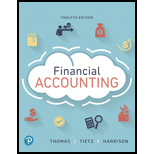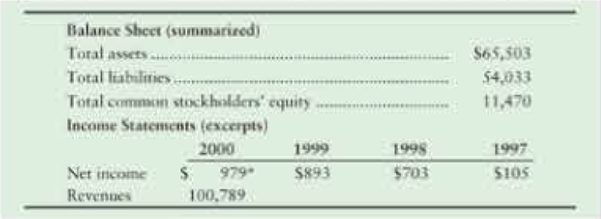
(Learning Objective 5: Explore an actual bankruptcy; calculate leverage ratio, ROA, debt ratio, and times-Interest-earned ratio) In 2002, Enron Corporation filed for Chapter 11 Q bankruptcy protection, shocking the business community: How could a company so large and successful go bankrupt? This case explores the causes and the effects of Enron's bankruptcy.
At December 31, 2000, and for the four years ended on that date. Enron reported the following (amounts in millions):

Unknown to Investors and lenders, Enron also controlled hundreds of
During the four-year period up to December 31, 2000, Enron’s stock price shot up from $17.50 to $90.56. Enron used its escalating stock price to finance the purchase of the SPEs by guaranteeing lenders that Enron would give them Enron stock if the SPEs could not pay their loans.
In 2001, the SEC launched an Investigation into Enron's accounting practices. It was alleged that Enron should have been including the SPEs In its financial statements all along. Enron then restated net income for the years up to 2000, wiping out nearly $600 million of total net income (and total assets) for this four-year period. Assume that $300 million of this loss applied to 2000. Enron's stock price tumbled, and the guarantees to the SPEs' lenders added millions to Enron's liabilities (assume the full amount of the SPEs' debt was included). To make matters worse, the assets of the SPEs lost much of their value; assume that their market value is only $500 million.
Requirements
1. Compute the debt ratio that Enron reported at the end of 2000. By using the DuPont Model, compute Enron's return on total assets (ROA) for 2000. For this purpose, use only total assets at the end of 2000, rather than the average of 1999 and 2000.
2. Compute Enron's leverage ratio for 2000. Use total assets and total
3. Add the asset and liability information about the SPEs to the reported amounts provided in the table. Recompute all ratios after including the SPEs in Enron's financial statements. Also compute Enron's times-interest-earned ratio both ways for 2000. Assume that the changes to Enron's financial position occurred during 2000.
4. Why does it appear that Enron failed to include the SPEs in its financial statements? How do you view Enron after including the SPEs in the company's financial statements? (Challenge)
Want to see the full answer?
Check out a sample textbook solution
Chapter 9 Solutions
Financial Accounting (12th Edition) (What's New in Accounting)
- What are possible reasons for a company with $20 million worth of assets that files for chapter 7 bankruptcy and a secured creditor with claims of over $100 million and the building as a secuirty end up with nothing?arrow_forwardWhen the Beacon Computer Company filed for bankruptcy under CCAA, it had the following balance sheet information: Liquidating Value claims Trade credit $ 6,400 Secured mortgage notes 9,600 Senior debentures 11,600 Junior debentures Total assets $30,100 Equity 16,600 -14,100 Assuming there are no legal fees associated with the bankruptcy, as a trustee, what distribution of liquidating value do you propose? (Do not leave any empty spaces; input a O wherever it is required. Omit "$" sign in your response.) Distribution of liquidating value Trade credit Secured mortgage notes Senior debentures Junior debentures Equity $arrow_forwardWhich of the following statements about WorldCom is true? a. WorldCom filed for Chapter 11 bankruptcy in 2002. b. They overreported the line costs by recording them as liabilities. c. It began in 1999 as Long Distance Discount Services, Inc. d. Five techniques were used to cook its books.arrow_forward
- Xavier Company is going through a Chapter 7 bankruptcy. All assets have been liquidated, and the company retains only $26,200 in free cash. The following debts, totaling $43,050, remain: Indicate how much money will be paid to the creditor associated with each debt.arrow_forwardWhen the Beacon Computer Company filed for bankruptcy under CCAA, it had the following balance sheet information: Liquidating Value Claims Trade credit $ 6,700 Secured mortgage notes 9,900 Senior debentures 11,900 Junior debentures Total assets $30,400 Equity 16,900 -15,000 Assuming there are no legal fees associated with the bankruptcy, as a trustee, what distribution of liquidating value do you propose? (Do not leave any empty spaces; input a O wherever it is required. Enter the answers in dollars. Omit $ sign in your response.) Trade credit Secured mortgage notes Senior debentures Junior debentures Equity Distribution of liquidating valuearrow_forwardXavier Company is going through a Chapter 7 bankruptcy. All assets have been liquidated, and the company retains only $25,200 in free cash. The following debts, totaling $38,050, remain: Government claims to unpaid taxes Salary during last month owed to Mr. Key (not an officer) Administrative expenses Salary during last month owed to Ms. Rankin (not an officer) Unsecured accounts payable $6,000 17,825 2,450 5,225 6,550 Indicate how much money will be paid to the creditor associated with each debt. (Be sure to list liabilities in the order of priority.) Administrative expenses Salary during last month owed to Mr. Key and Ms. Rankin Government claims to unpaid taxesarrow_forward
- Xavier Company is going through a Chapter 7 bankruptcy. All assets have been liquidated, and the company retains only $26,800 in free cash. The following debts, totaling $46,050, remain: $ 7,600 Government claims to unpaid taxes Salary during last month owed to Mr. Key (not an officer) Administrative expenses 19,425 4,050 Salary during last month owed to Ms. Rankin (not an officer) Unsecured accounts payable 6,825 8,150 Indicate how much money will be paid to the creditor associated with each debt. Types of Debts Amountsarrow_forward(b) Grouper' major customer shocked the industry on January 14 by declaring bankruptcy. There had been no warning to ANBS of this customer's impending financial collapse, and Grouper had not accrued any Allowance for Expected Credit Losses specific to this customer. At the end of the fiscal year, the customer owed more than $130,000 to Grouper. Identify the effect that it will have on Grouper's 2023 net income. Ignore taxes. Net income will ✓ by $arrow_forwardGovernment claims to unpaid taxes Salary during last month owed to Mr. Key (not an officer) Administrative expenses Salary during last month owed to Ms. Rankin (not an officer) Unsecured accounts payable Required: Indicate how much money will be paid to the creditor associated with each debt. Types of Debts Administrative expenses Salary during last month owed to Mr. Key and Ms. Rankin Government claims to unpaid taxes Amounts $ 4,150 $ 7,700 19,525 4,150 5,930 8,250arrow_forward
- Olds Company declares Chapter 7 bankruptcy. The following are the asset and liability book values at that time. Administrative expenses are estimated to be $20,000: The holders of note payable B want to collect at least $129,000. To achieve this goal, how much does the company have to receive in the liquidation of its equipment?arrow_forwardAt the time it defaulted on its interest payments and filed for bankruptcy, the McDaniel Mining Company had the balance sheet shown here (in thousands of dollars). The court, after trying unsuccessfully to reorganize the firm, decided that the only recourse was liquidation under Chapter 7. Sale of the fixed assets, which were pledged as collateral to the mortgage bondholders, brought in $400,000, while the current assets were sold for another $200,000. Thus, the total proceeds from the liquidation sale were $600,000. The trustee’s costs amounted to $50,000; no single worker was due more than the maximum allowable wages per worker; and there were no unfunded pension plan liabilities. Balance Sheet (Thousands of Dollars) Current assets $ 400 Accounts payable $50 Net fixed assets 600 Accrued taxes 40 Accrued wages 30 Notes Payable 180 Total current liabilities 300 First-mortgage bonds $300 Second-mortgage bonds 200 Debentures 200…arrow_forwardAtaway Company has severe financial difficulties and is considering filing a bankruptcy petition. At this time, it has the following assets and liabilities. The assets are stated at net realizable value. Assets (pledged against debts of $70,000) . . . . . . . . . . . . . . . . $116,000Assets (pledged against debts of $130,000) . . . . . . . . . . . . . . . . . 50,000Other assets . . . . . . . . . . . . . . . 80,000Liabilities with priority . . . . . . . 42,000Other unsecured creditors . . . 200,000 In a liquidation, how much money would be paid on the partially secured debt?arrow_forward

 Financial Reporting, Financial Statement Analysis...FinanceISBN:9781285190907Author:James M. Wahlen, Stephen P. Baginski, Mark BradshawPublisher:Cengage Learning
Financial Reporting, Financial Statement Analysis...FinanceISBN:9781285190907Author:James M. Wahlen, Stephen P. Baginski, Mark BradshawPublisher:Cengage Learning

